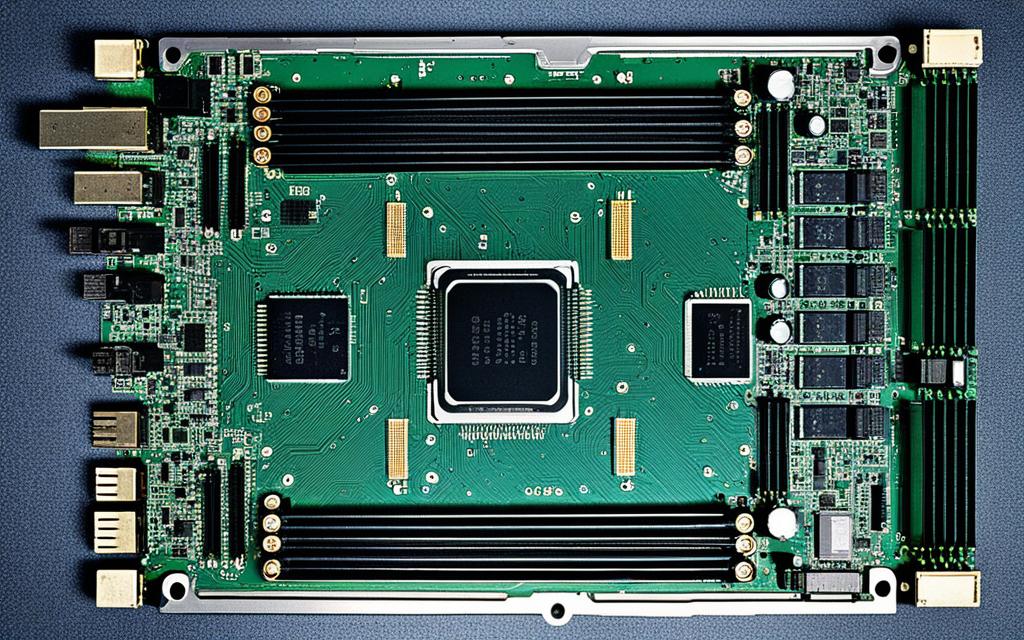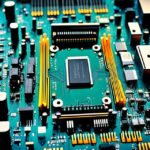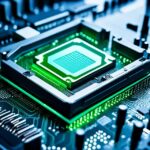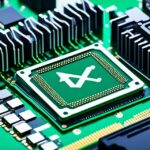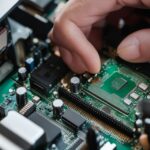Table of Contents
In computer hardware, people often ask if a motherboard can finish a Power-On Self-Test (POST) without a CPU. It’s key to know this for fixing computers and knowing if things are compatible. The truth is, a motherboard needs a CPU to post. This is because the CPU runs instructions and does calculations for the POST1. Without a CPU, the motherboard doesn’t have what it takes to start POST, so the system won’t work1. The CPU’s role is crucial. It makes sure everything runs smoothly and prevents hardware problems. This shows how important the CPU is to the motherboard1. We’ll look more into how motherboards work and why POST is important with this vital hardware mix.
Key Takeaways
- A motherboard cannot post without a CPU.
- CPU is essential for executing instructions and initiating POST.
- The lack of a CPU prevents the motherboard from functioning properly.
- Modern motherboards include safety mechanisms to protect against operation without a CPU.
- Error messages and beeping codes may signal issues when attempting to post without a CPU.
Understanding the Basics of Motherboard Functionality
The motherboard is key to a computer’s operation, linking various parts together. It ensures smooth communication among these parts, affecting how well the computer works. Without a CPU, the motherboard can’t do its job, especially at the start. Knowing its main parts helps us see how much it relies on them.
What is a Motherboard’s Role?
A motherboard is vital for any computer. It connects the CPU, GPU, RAM, and storage so they work well together. It usually has a chipset which helps the CPU and other parts talk to each other. These motherboard components are:
- Chipset: Manages the data flow between the processor and extras.
- Memory Slots: Holds RAM for quick data use and storage.
- Power Connectors: Powers the motherboard and its connected parts.
- I/O Ports: Lets you connect external devices, like keyboards.
Components Required for Initial POST
The first POST, or Power-On Self-Test, checks if the computer has the parts it needs to start. Every motherboard needs a CPU to begin this. This fact highlights how vital the CPU is2. Without it, the motherboard won’t start, causing error messages about missing the CPU3. For a POST to work, you need these items:
| Component | Description | Importance for POST |
|---|---|---|
| CPU | Central Processing Unit, the computer’s brain | Crucial for running the POST |
| RAM | Random Access Memory, for short-term data | Important for checking the system’s performance |
| Power Supply | Gives power to the motherboard and its parts | Key for starting the boot-up processes |
| Firmware (BIOS) | The basic software that starts with the computer | Runs first during boot-up |
Knowing these parts is crucial for understanding the motherboard’s startup process. It also helps in fixing any startup issues324.
Will a Motherboard Post Without a CPU?
Trying to start a POST sequence without a CPU brings up important points. Most motherboards need a CPU to do the POST successfully. Usually, the motherboard will turn on, shown by LED lights or fan activity. But without a CPU, it can’t finish the POST. The CPU is vital for running instructions and checks56.
What Happens During a POST Without a CPU?
The POST process stops if the motherboard can’t check the CPU. Even if power gets to the motherboard, it can’t do much6. It won’t move on to start the operating system, because that needs the CPU6.
Error Indicators You Might Encounter
Certain motherboard error indicators show when a POST fails without a CPU. Look out for error lights or beep sounds. They tell you something’s wrong. It’s key to know these signs to fix problems. So, when building or updating a PC, make sure the CPU and motherboard work well together56.
Possible Outcomes When Testing a Motherboard Without a CPU
Testing a motherboard without a CPU can have different results. These are often shown by LED indicators and beeping sounds. It’s crucial to understand these signs to figure out hardware problems.
LED Indicators and Beeping Codes Explained
When trying to start a motherboard without a CPU, certain LED lights will turn on. This tells us what might be wrong. For example, a solid red light usually means a major error. Flashing lights may point to issues like memory problems or not enough power. The beeping sounds are also a way to tell what’s wrong; Each beep pattern links to a different hardware issue. Knowing these sounds helps quickly find out what part isn’t working right.
Impact on Other Connected Components
Not having a CPU affects not just the motherboard but also other parts connected to it. Components like memory modules won’t work because there’s no CPU to help them talk to each other. Trying to turn on a motherboard without a CPU might even cause overheating. It can also lead to more problems because modern motherboards try to stop wrong use. This can be annoying because the motherboard needs its main part to work at all.
In short, no CPU means LED lights and beeps will tell us what’s wrong with the motherboard. But, it also means other parts might not work right because they can’t talk to each other. Knowing how to test correctly can stop damage and help find and fix problems17.
The Importance of a Compatible CPU
It’s essential to ensure a CPU fits well with a motherboard for a successful computer build. Often, CPUs may not work with motherboards due to different architectures or chipsets. This mismatch stops the computer from doing basic tasks. For a computer to start, it needs a CPU that matches the motherboard’s requirements.
Common Compatibility Issues
One usual problem is when a motherboard needs a BIOS update to support a CPU. Without this update, the motherboard might not start properly. This makes setting up the system difficult. It shows why knowing both the CPU’s and motherboard’s details is crucial for a good match.
How to Check Compatibility Before Installation
To prevent issues, using a motherboard compatibility checker is wise. This tool shows which CPUs will fit, ensuring everything works well together. Also, looking at the manufacturer’s specs and compatibility lists helps. Checking reliable guides can also be helpful in confirming if the CPU will work before you install it.
Conclusion
In summary, the exploration of motherboard functionality shows a truth. A motherboard can’t post without a CPU. The CPU’s role is critical as it starts the system’s boot-up processes. Without the CPU, figuring out what’s wrong gets tough. The motherboard might turn on, but it won’t work right. This can lead to confusion and frustration when trying to find the problem.
Thinking about the match between CPU and motherboard is key for smooth operation. Although some high-end motherboards have ways to diagnose problems without a full POST, these are exceptions. Most of the time, a well-matched CPU and motherboard are essential. They help users navigate the BIOS and allow hardware and software to talk to each other effectively89.
Going forward, checking all components carefully will make systems more reliable and improve computing. With careful troubleshooting, users can find and fix issues. This ensures a system that works well. Keeping these ideas in mind will help both enthusiasts and professionals make better choices in their hardware projects.
FAQ
Can a motherboard perform a Power-On Self-Test (POST) without a CPU?
No, it can’t perform a POST without a CPU. The CPU processes the initial instructions for the POST.
What indicators might I see if I try to POST without a CPU?
You may see LED lights come on and fans spin. Yet, the motherboard won’t complete the POST. Error signals like beeping codes could indicate the CPU is missing.
How can I verify if my CPU is compatible with a specific motherboard?
Check the motherboard’s specifications or compatibility lists on their website. This ensures that the CPU and motherboard will work together well.
Issues often arise from mismatched socket types and unsupported CPU generations. Wrong voltage settings can also cause problems.
What components are essential for the initial POST process on a motherboard?
The chipset, memory, power connectors, and I/O ports are crucial for POST. These parts must work together at startup.
How can LED indicators and beeping codes help in troubleshooting?
LED and beep codes offer clues about hardware problems. They make it easier to figure out what needs fixing.
Source Links
- https://softwareg.com.au/blogs/computer-hardware/will-a-motherboard-post-without-a-cpu-1 – Will A Motherboard Post Without A CPU
- https://rog-forum.asus.com/t5/hardware-build-advice/noob-question-can-you-start-the-motherboard-without-a-cpu/td-p/786904 – NOOB QUESTION: Can you start the motherboard without a CPU ?
- https://www.partitionwizard.com/news/can-a-pc-run-without-a-cpu.html – Can a PC Run Without a CPU – Everything You Should Know
- https://www.tutorialsweb.com/computers/pc-motherboard.htm – Motherboard Components And The Functions Explained
- https://thetechsnews.com/will-a-motherboard-post-without-a-cpu/ – Will A Motherboard Post Without A Cpu
- https://softwareg.com.au/blogs/computer-hardware/will-a-motherboard-post-without-a-cpu – Will A Motherboard Post Without A CPU
- https://forum.level1techs.com/t/can-a-faulty-cpu-prevent-a-motherboard-from-powering-on/191297 – Can a faulty CPU prevent a motherboard from powering on?
- https://www.techyplays.com/will-a-motherboard-post-without-a-cpu/ – Will A Motherboard Post Without A CPU – The Complete Guide!
- https://ms.codes/blogs/computer-hardware/will-a-motherboard-post-without-a-cpu – Will A Motherboard Post Without A CPU

